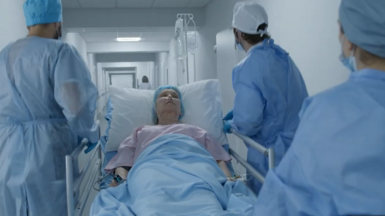Case inventory study from Sweden concerning association of Pandemrix vaccination and reports of narcolepsy with cataplexy in children and adolescentsArchived
ECDC has previously summarised information concerning the appearance of narcolepsy following the use of a specific pandemic vaccine (Pandemrix®) in children and adolescents in three European Countries.
ECDC has previously summarised information concerning the appearance of narcolepsy following the use of a specific pandemic vaccine (Pandemrix®) in children and adolescents in three European Countries.(1-3) In its late March update ECDC detailed how an unexpectedly high number of reports of narcolepsy in children and adolescents following vaccination with one of the pandemic vaccines (Pandemrix) was investigated by the Swedish Medical Product Agency. The Agency performed and published in March 2011 a registry-based study in four counties/regions of Sweden using immunization registries and local health care databases covering a population of 5.1 million (57% of the Swedish population). That found a four-fold increased risk of developing narcolepsy diagnosed in vaccinated children and adolescents (4-19 years) versus unvaccinated in the same age group. No similar increase was observed in other age groups.(2)Now the same Swedish Agency has published a second case inventory study focusing on all children and adolescents (younger than 20 years) in Sweden with severe narcolepsy with cataplexy, identified during a two-year period from 1st of January 2009 to 31st of December 2010 through departments of neurology, paediatrics, paediatric neurology, paediatric psychiatry, and sleep and clinical physiology laboratories.(4) Onset of symptoms was evaluated in identified cases (n=87) and cases were classified according to the American Academy of Sleep Medicine criteria for narcolepsy with cataplexy.(1) Six cases had onset of symptoms before January 2009 and were excluded. In the remaining 81 cases, 69 cases had received Pandemrix before onset of first symptoms and 12 cases were classified as unimmunised.
Population incidence trends
Of the immunised cases, 53 (76.8%) had onset of disease within three months post vaccination. The overall incidence rate over time was 1.85 per 100 000 person-years. Individuals were assigned to calendar quarters of a year according to onset of symptoms. In quarters one to three in 2009, before pandemic vaccination started, the incidence rates ranged between 0.18-0.37 per 100 000 person-years, while the incidence rates in quarter four of 2009 and quarter one and two of 2010 were much higher at 4.94, 6.58 and 2.0 per 100 000 person-years, respectively. During the last six months of the study period the incidence rates have returned to the level observed before the pandemic/vaccination at 0.18 per 100 000 person-years. Age-specific incidence rates were: 0.31 per 100 000 person-years in those 0-4 years of age, 2.18 per 100 000 person-years in those 5-9 years of age, 3.52 per 100 000 person-years in those 10-14 years of age, and 1.72 per 100 000 person-years in those 15-19 years of age. Different incidence rates per 100 000 person-years were observed in six geographic health administration regions; with rates ranging from 2.14 to 2.99 per 100 000 person-years in the three most southern regions, the central regions’ rates ranging from 0.99 to 1.88 per 100 000 person-years while the northern region had the lowest rate of 0.25 per 100 000 person-years.
Comparison of incidence rates in vaccinated and non-vaccinated cohorts – overall the incidence rate in those vaccinated was 4.2 per 100 000 person-years versus 0.64 per 100 000 person-years in unvaccinated, which translates into a relative risk of 6.6 (95% CI 3.1 -14.5) and an absolute risk of 3.6 (95%CI 2.5 – 4.7) additional cases per 100,000 vaccinated individuals or 1 case per 27,800 vaccinations (95%CI from 1 per 21,300 to 1 per 40,000 vaccinations).
Comparison of characteristics of vaccinated and non-vaccinated cases – median age of immunised cases was 13 years (range 3-19) and of unimmunised cases 12 years (range 6-17 years). Cataplexy (sudden and transient episode of loss of muscle tone, often triggered by emotions) was observed in the month of onset in as many as 43% of the immunised cases and in 8% of the unimmunised (p=0.02). Also the presence of two or more symptoms (daytime sleepiness, cataplexy, hypnagogic hallucinations -hallucinations occurring just before falling asleep, disturbed night time sleep and sleep paralysis) was more common in the immunised cases, at 46% versus 17% in the unimmunised cases (p=0.0543).Laboratory and clinical investigations included hypocretin levels in the CSF (cerebro-spinal fluid), Multiple Sleep Latency Test (MSLT - testing how quickly a person falls asleep), tests for HLA types known to be associated with narcolepsy HLA DQB1*0602, HLA DRB2 and magnetic resonance (MR) or computed tomography (CT) . (4,5). As is commonly recognised with narcolepsy cases CSF hypocretin levels were low in all investigated individuals: in 35% and 42% immunised and unimmunised subjects, respectively. MSLT test was positive in 88% of immunised and 75% of unimmunised individuals. The previously recognised HLA types for narcolepsy were present in 94-100% of all individuals, immunised and unimmunised.(4,5) The MRI/CT results were normal in 90% of all immunised and 100% of all unimmunised individuals. Abnormal weight gain was more common in the immunised group (65% of cases) than in the unimmunised group (33% of cases) but the difference was not statistically significant.
ECDC comment (June 29th)
This case inventory study showed an association between vaccination with Pandemrix (possibly in combination with some unknown factor) and an increased risk of narcolepsy with cataplexy, with the estimate of relative risk of over 6 (vaccinated compared to unvaccinated cases) and absolute risk of 1 new case per 27,800 vaccinations. The strength of this study is that all medical charts of affected individuals were reviewed independently by two neurologists and date of onset of symptoms has been established. A further strength is that selecting only cases with severe narcolepsy with cataplexy should have reduced the risk of stimulated reporting (increased reporting due to media and professional interest). However, the study also has limitations which are acknowledged. It is not subject to peer review and is based on review of medical records. No direct interviews with patients have been conducted. Time of onset of narcolepsy was estimated based on the first recorded symptoms suggestive of narcolepsy. The level of completeness of data on cases of narcolepsy included in this study is unknown as the cases have been identified through the national patient statistics for in-patients and outpatients which is known to have lags in data transfer. Further, extrapolating vaccine exposure from a regional study to national level is problematic due to the lack of immunization registry covering the whole country and no data availability on possible confounders. It should also be remembered that a number of these cases will have been reported and analysed in the first Swedish study.(2) No adjustment for confounding was attempted in this analysis as the investigators had no access to data on potential confounders. In February 2011 Finland reported a 9-fold increase of risk of narcolepsy in vaccinated individuals compared to unvaccinated. Two more countries, France and Norway, have reported a more modest increase of narcolepsy reports in their spontaneous reporting systems of adverse events following immunization and have started investigations. At the EU/EEA level the ECDC VAESCO multi-country case control study will perform its first interim analysis early July in preparation for the upcoming expert meeting organized by the European Medicines Agency (EMA) in preparation for further possible regulatory decisions at the EMA CHMP meeting. As stated before in this series of Public Health Developments it is important to understand the possible biological mechanisms behind these cases by investigating environmental, genetic and other possible factors that could have contributed to the observed increased risk.(1-3) It should be noted that no such association has been observed with seasonal influenza vaccines.




